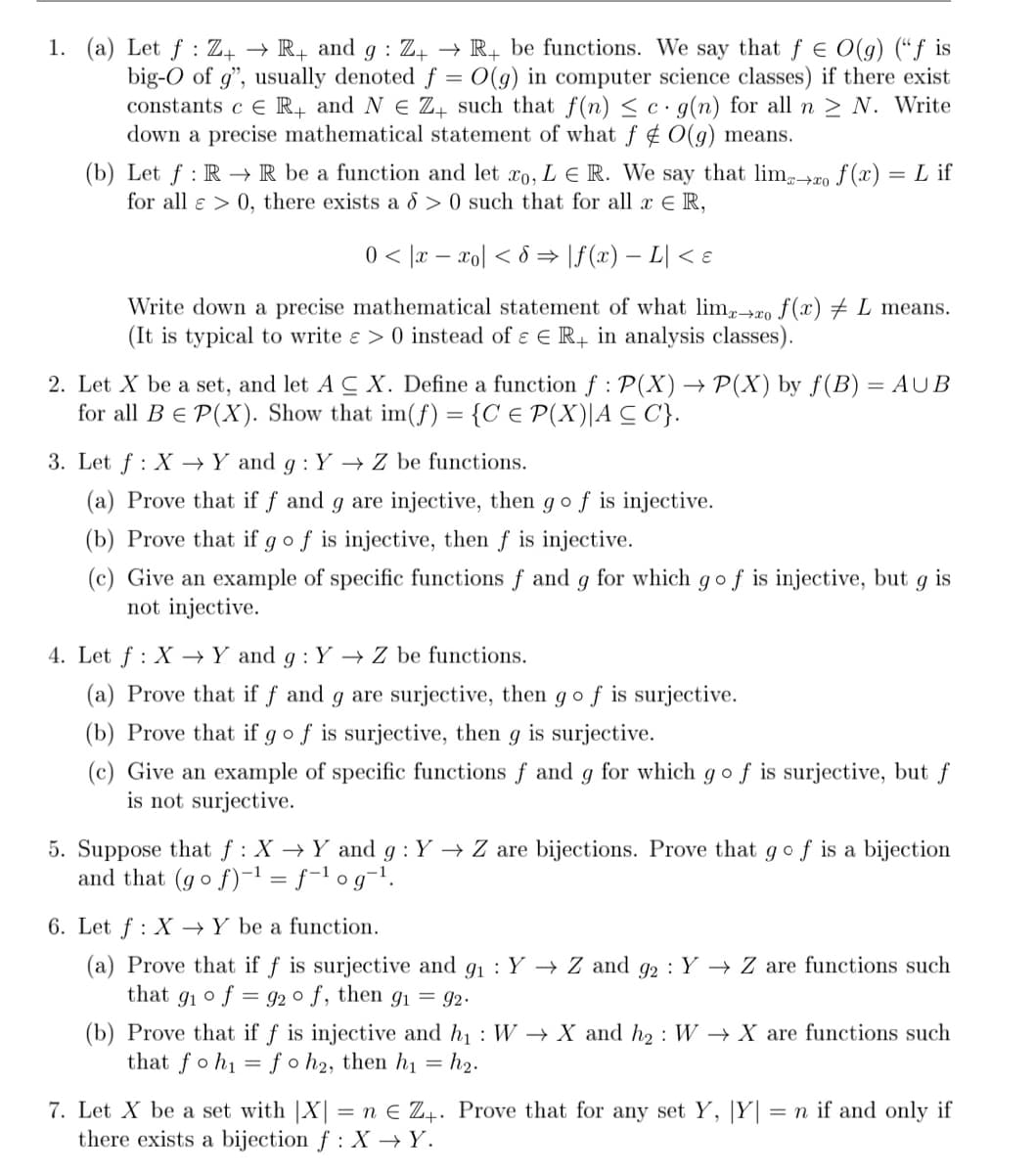6. Let f : X →Y be a function. (a) Prove that if f is surjective and g1 : Y → Z and g2 : Y → Z are functions such that g1 o f = 92 o f, then g1 = 92. (b) Prove that if f is injective and h : W → X and h2 : W → X are functions such that foh1 = f o h2, then h1 = h,.
6. Let f : X →Y be a function. (a) Prove that if f is surjective and g1 : Y → Z and g2 : Y → Z are functions such that g1 o f = 92 o f, then g1 = 92. (b) Prove that if f is injective and h : W → X and h2 : W → X are functions such that foh1 = f o h2, then h1 = h,.
Linear Algebra: A Modern Introduction
4th Edition
ISBN:9781285463247
Author:David Poole
Publisher:David Poole
Chapter6: Vector Spaces
Section6.5: The Kernel And Range Of A Linear Transformation
Problem 30EQ
Related questions
Question
Q6
Mathmatical reasoning
please with full explanation and steps. thx. typed answers will be appreciated

Transcribed Image Text:1. (a) Let f : Z+ → R+ and g : Z4 → R+ be functions. We say that f E O(g) (“f is
big-O of g", usually denoted f = 0(g) in computer science classes) if there exist
constants c e R, and N E Z̟ such that f(n) < c· g(n) for all n > N. Write
down a precise mathematical statement of what f ¢ O(g) means.
(b) Let f : R –→ R be a function and let ro, L E R. We say that lim+ro f (x) = L if
for all e > 0, there exists a 8 > 0 such that for all x E R,
0 < |x – xo| < 8 → \f(x) – L| < ɛ
Write down a precise mathematical statement of what lim,-20 f(x) # L means.
(It is typical to write e > 0 instead of ɛ E R in analysis classes).
2. Let X be a set, and let A C X. Define a function f : P(X) → P(X) by f(B) = AUB
for all BE P(X). Show that im(f) = {C € P(X)|A C C}.
3. Let f : X →Y and g : Y → Z be functions.
(a) Prove that if f and g are injective, then g o f is injective.
(b) Prove that if g o f is injective, then f is injective.
(c) Give an example of specific functions f and g for which g o f is injective, but g is
not injective.
4. Let f : X –→Y and g : Y → Z be functions.
(a) Prove that if f and g are surjective, then gof is surjective.
(b) Prove that if gof is surjective, then g is surjective.
(c) Give an example of specific functions f and g for which gof is surjective, but f
is not surjective.
5. Suppose that f : X →Y and g : Y → Z are bijections. Prove that gof is a bijection
and that (go f)-1 = f-l og¬1.
6. Let f : X →Y be a function.
(a) Prove that if f is surjective and g1 : Y → Z and g2 : Y → Z are functions such
that gi ° f
= 92 o f, then g1 = 92.
(b) Prove that if f is injective and h1 : W → X and h2 : W → X are functions such
that foh1 = f o h2, then hi
= h2.
7. Let X be a set with |X| = n E Z4. Prove that for any set Y,
there exists a bijection f : X →Y.
|Y|
= n if and only if
Expert Solution
This question has been solved!
Explore an expertly crafted, step-by-step solution for a thorough understanding of key concepts.
This is a popular solution!
Trending now
This is a popular solution!
Step by step
Solved in 2 steps with 1 images

Recommended textbooks for you

Linear Algebra: A Modern Introduction
Algebra
ISBN:
9781285463247
Author:
David Poole
Publisher:
Cengage Learning


Elements Of Modern Algebra
Algebra
ISBN:
9781285463230
Author:
Gilbert, Linda, Jimmie
Publisher:
Cengage Learning,

Linear Algebra: A Modern Introduction
Algebra
ISBN:
9781285463247
Author:
David Poole
Publisher:
Cengage Learning


Elements Of Modern Algebra
Algebra
ISBN:
9781285463230
Author:
Gilbert, Linda, Jimmie
Publisher:
Cengage Learning,

Algebra & Trigonometry with Analytic Geometry
Algebra
ISBN:
9781133382119
Author:
Swokowski
Publisher:
Cengage